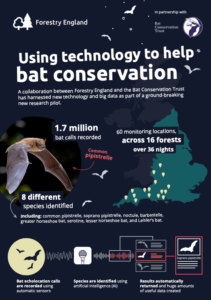AI-assisted sound identification tools are being deployed in UK forests to help better understand the behaviour of protected bat species and the health of woodlands and biodiversity more generally.
The pilot, reportedly the first of its kind in the UK, emerged from a collaboration between Forestry England and the Bat Conservation Trust. The partnership is testing AudioMoth, a low-cost static acoustic sensor featuring AI-based sound identification, to discover more about the bats living in the nation’s forests and contribute to conservation efforts.
 According to the team, prior to using AudioMoth, it had been considered too costly to use bat detecting equipment for large scale surveys in woodland.
According to the team, prior to using AudioMoth, it had been considered too costly to use bat detecting equipment for large scale surveys in woodland.
To date, AudioMoth has been implemented in 60 monitoring locations across 16 forests and some 400 surveys have recorded 7,000,000 potential bat calls.
The team completed data analysis over the winter using AI tools developed by researchers at University College London and successfully identified 1.7 million bat calls to eight species and two species groups.
Andrew Stringer, head of environment at Forestry England, called the technology a “game-changer”, and said: “This pilot has been extraordinary. It gave us more data than we’ve ever had to work with before and it is fantastic to see new technology being used for robust conservation science.
“Monitoring and evidence are the bedrock of conservation efforts, and it is tremendously exciting to look to the future and how these methods might give us crucial insight into how bat populations are performing in the long-term.”








